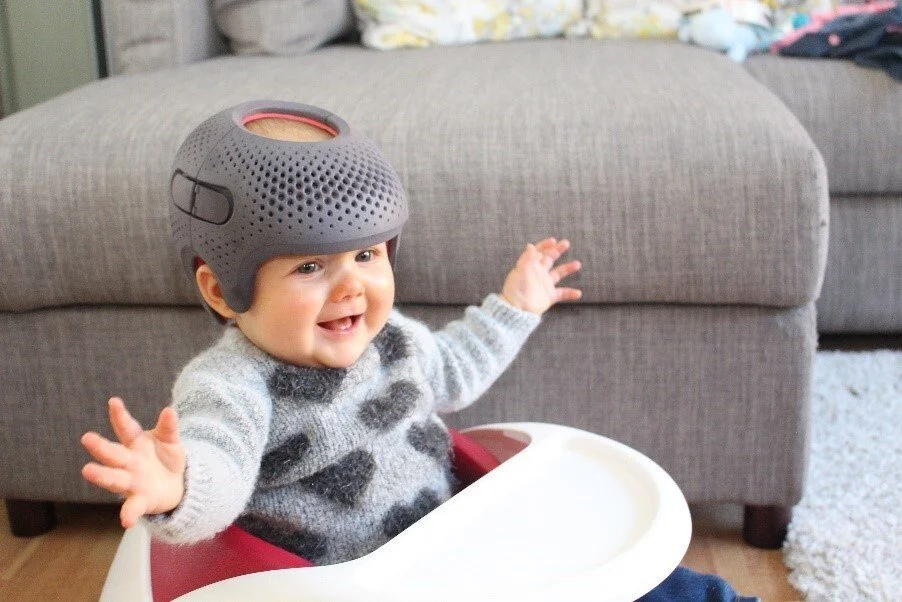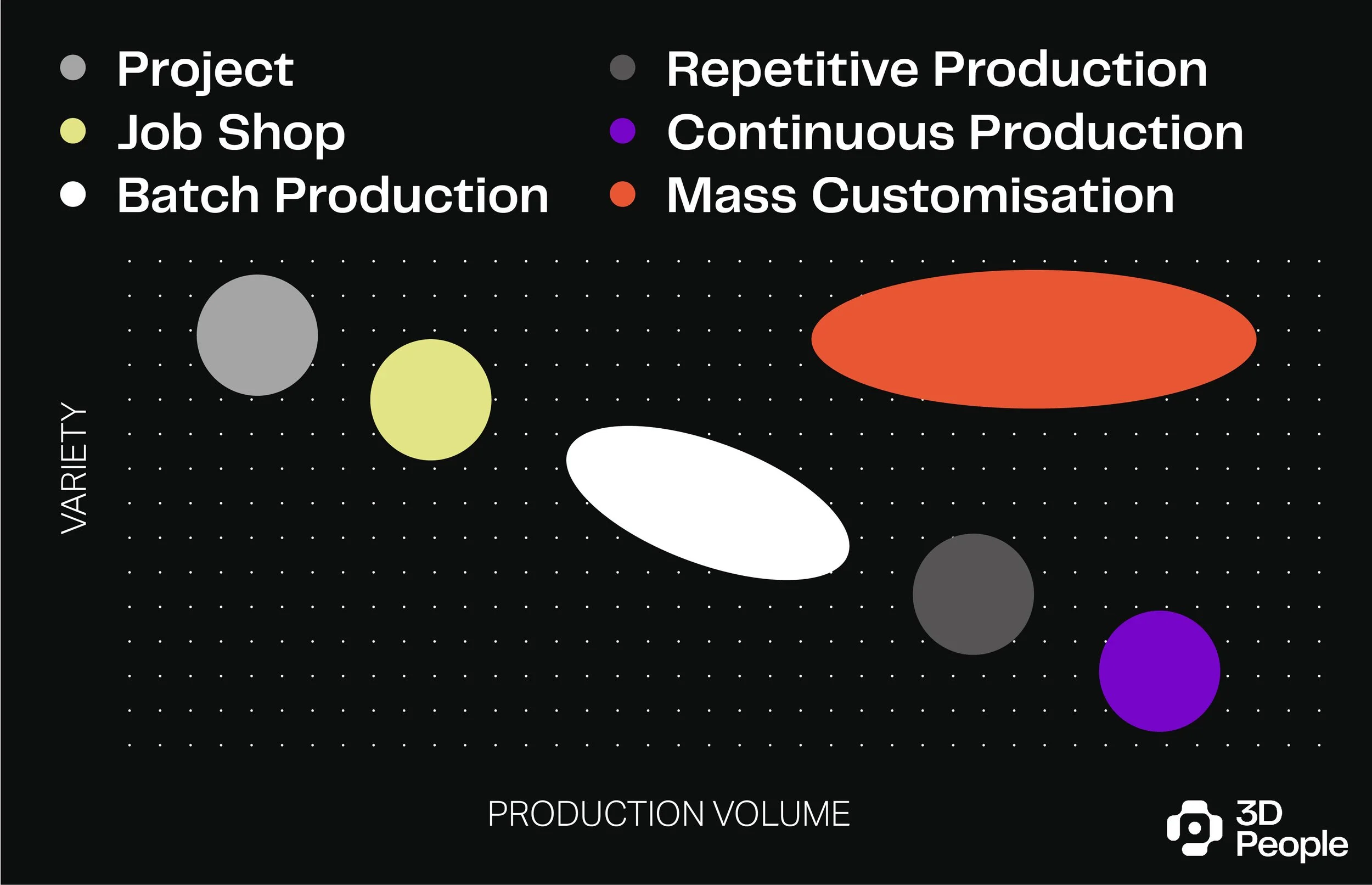Mass Customisation with 3D Printing
Can we deliver truly bespoke products on a mass production scale? With 3D printing, you can.
Additive manufacturing, more commonly known as 3D printing, rocketed into the mainstream media several years ago, and has become the first choice for certain types of manufacturing business models, products and services. 3D printing unlocks some key benefits over injection moulding and CNC machining and generally has a strong business case for high-value products produced on a made-to-order basis.
The technology has matured in recent years; 3D printing has established itself as a reliable and efficient fabrication method. Its near unlimited design potential, combined with the ability to rapidly produce components on-site and on-demand, make it an ideal choice for many manufacturing applications.
Manufacturers are discovering that 3D printing can be used for high quality batch production of end-use components.
3D printing materials, hardware and software have evolved to the point where the mechanical and aesthetic quality achievable is comparable to the more traditional forming or fabricating methods. This makes 3D printing of some or all of the components in short to medium-sized batches or product runs the most cost-effective method of production.
Low volume batch production of PA12 Nylon (SLS) parts 3D People
However, the majority of brands and businesses are still missing a major opportunity to strengthen their USP, to add additional value to their product offering and to improve the relationship with their customers. 3D printing, a digital manufacturing technology, allows for near-limitless complexity within your components and parts. The manufacturing cost per unit is proportional to the volume of material used, not the geometry of the parts produced - a major difference to injection moulding and CNC machining.
3D printing means both complexity and product variety are free and add value to your product or service.
The ability to offer personalisation and customisation with no additional production cost is a great opportunity to add value to your products and increase sales. Consumers understand the advantages of customised, unique products better suited to their needs and requirements - it gives them the added feeling that their product is special.
Let’s take a real world example - a bicycle helmet. Typically, this product comes in a small range of sizes, despite the huge variety across the population's head size and shape depending on age, gender, height and more. If you could purchase this product to fit exactly to your body, and also choose the colour and design, would you?
It would be costly for manufacturers to create custom moulds for each individual order, however, if customising a helmet were just as quick and cost-effective as producing a standard helmet, it would be a great addition to the market and would appeal to customers.
Welcome to the manufacturing concept of mass customisation.
Mass customisation combines large scale production with highly customised products.
Achieving mass customisation means maintaining the low cost per unit typically seen in the mass production of products, whilst also delivering highly customised goods at an increased price point to your customers. The idea is that a more valuable product is delivered to the customer to maximise company profitability.
Production Volume & Variety Relationship
One of the earliest adopters of 3D printing technology and a great example of mass customisation is the hearing aid industry. No two ear canals are quite the same, the product value is high and the ability to personalise and customise it to a user's needs adds clear product value. For this reason, almost 100% of hearing aids today are manufactured using 3D printing.
3D printing and mass customisation are symbiotic, a match made in heaven.
3D printing is a digital manufacturing process, and this is important because it lays the foundations for offering true mass customisation. Physical tooling isn’t required in 3D printing like it might be for CNC machining and injection moulding. Through the setup of the right digital tools, customisation and personalisation choices can be captured, digitised and processed to output individualised digital files that can be used for 3D printing large scale production.
The use of modularity in products can support efforts to achieve true mass customisation. Not all components in a given assembly are important to the customer in terms of personalisation or customisation, and the use of common modular joints, attachment methods and geometries in these areas can provide an element of standardisation and of design control over the customisation process. Maintaining control over customisation is important, as companies will need to find the right balance between offering products tailored to consumer needs, whilst ensuring the brand and product identity is protected and intact.
Indirect mass customisation is also possible with 3D printing.
It can also be possible to indirectly facilitate mass customisation of other manufacturing methods, through the use of 3D printing. It can be a challenge for traditional manufacturing methods like moulding and casting to produce customised parts on shorter lead time, due to the time required to manufacture tools and fixturing to start work. Utilising 3D printing for the manufacturing of moulds and fixturing is an excellent way to indirectly facilitate mass customisation of products. A great example is RapidFit Automotive Tooling, where fixtures for new and custom car body parts can be generated through AI and software within minutes and manufactured within hours. Volvo were able to implement this below to streamline their production process at specific stages within their production line.
Volvo Car Gent gluing jig - RapidFit Automotive Tooling
Software solutions are critical to achieving true mass customisation.
Strong links between the consumer needs and the customisation software is essential in supporting the delivery of mass customisation. Without the ability to automate how customers can make the most desirable product or features choices at both the data capture and file processing stages, true mass customisation is limited in scale.
Product customisation software solution is required to provide a window to the consumer of the product they plan to purchase. A visual display of the configuration, customisation and personalisation of a product is an excellent way to sell to the customer the added value of purchasing their bespoke product, before starting any manufacturing. The use of augmented reality to visualise 3D renders of the end product in your customers environment adds another element of realism to the purchasing process. 3D scanning equipment is another method of capturing data and digitising it into the format required for file modification and processing.
Once the critical data for tailoring to your customers requirements has been captured, this needs to be used to automate the modification of the existing digital CAD model and prepare it for 3D printing. Twikit is one of several innovative software development companies focused on creating solutions to facilitate mass customisation of products and provide an end to end toolkit for capturing and processing data into manufacturable formats.
Mass customisation offers some clear benefits to both manufacturers and customers, with a number of exciting examples currently in production today.
Mass customisation in the Orthotics Industry
The Orthotics industry, where devices are used to help correct structural issues or provide support to the human body, is one where the use of personalised, made-to-fit products are improving performance and being profoundly more responsive to individual users' healthcare needs. The use of 3D printing with input scan data can ensure every device is tailored to an individual's needs, whilst manufacturing these at the same pace and same unit cost.
“3D printing excels at personalization and customization,” says Philipp Jung, global head of orthotic solutions at Hewlett Packard, and general manager of Arize, Hewlett Packard’s new orthotics solution. “And there’s nothing more personal than the human body.”
Arize Orthotic Solution - HP Inc
The TiMbandAir, also known as Talee in European countries, utilises cutting-edge custom 3D printing technology for a more advanced treatment option for flat head syndrome, ensuring increased comfort and care.
TiMbandAir - orthotic for plagiocephaly (head shape deformity)
The market for custom health and wellness solutions, orthotics and prosthetics is valued at over $10 billion, according to Hewlett Packard. This is set to continue to grow as healthcare requirements increase and the world population continues to increase in average age and lifespan.
“3D printing has offered us a freedom to design and manufacture,” says Deepak Kalaskar, an associate professor in the Department of Orthopaedic and Musculoskeletal Science at University College London, with expertise in biomedical engineering. “We are currently very much at the infancy of 3D printing, but that’s not stopping anyone from thinking about how we are going to use this revolutionising technology.”
Mass customisation in the Manufacturing Industry
In batch manufacturing, creating serialised or individually coded parts has always created an additional step in the manufacturing process, requiring additional equipment and labour resources. The use of 3d printing to manufacturing products can eliminate this step, without additional time or cost. The parts can be individualised in any way the manufacturer requires - including utilising QR codes, personalising items (e.g. names of employees) to custom images.
Through robust software solutions, individual parts in large batches of 1000+ components can be 3d printed with part numbers, batch details, date of manufacturing and any other details the end customer requires to manage their own stock and quality accordingly.
Mass customisation in the Automotive industry
BMW MINI launched an initiative for existing MINI owners to allow them to customise their different car facia and dashboard parts to their liking. Owners can purchase customised outside panes with their names, own designs and text.
BMW MINI custom car facia
An online configurator can be used to add text, images, decide on colours and finishes for the different customisable parts. The user can decide on fully unique parts that are made to order. The unique items are then mass produced in just a few days using industrial 3D printing technology before being installed by a local MINI dealer. The cost and time to print a customised, or a standard part is the same.
Mass customisation in Consumer Goods
Hexr has created the world’s first custom fit bicycle helmet. They have developed their own digital workflow utilising software and a digital manufacturing process, 3D printing, which enables them to mass customise the goods it sells.
Customers first use the Hexr app with its built-in proprietary scanning software and a smartphone camera to take head measurements, personalise the product, and purchase it.
Hexr custom-fit bicycle helmets
The unique, fully bespoke helmet is then produced as part of a mass production line and shipped to the customer.
In summary, mass customisation can be an excellent way for you to better connect with your customers to build a long lasting relationship. If implemented correctly, you can maximise your product value whilst keeping control of your manufacturing costs, strengthening your competitiveness as a business. Mass Customisation brings the following business benefits to those that successfully implement it within their production line.
Increased product value & profit margin
Stronger and longer lasting customer relationships
Improved manufacturing flexibility & business competitiveness
At 3D People, we’re here to help and advise on your manufacturing strategy across multiple technologies and materials. Get in touch today to start the quotation process.











